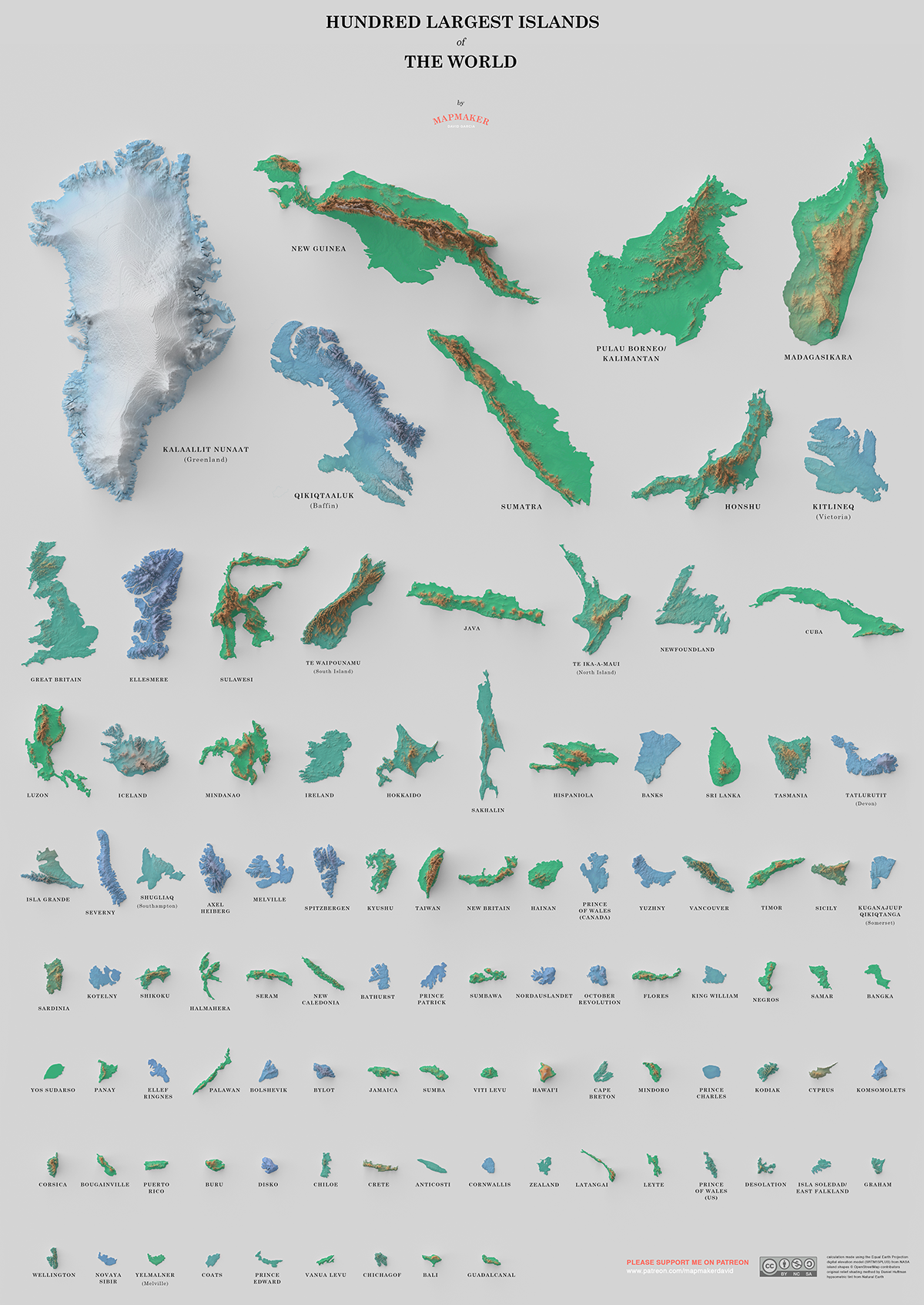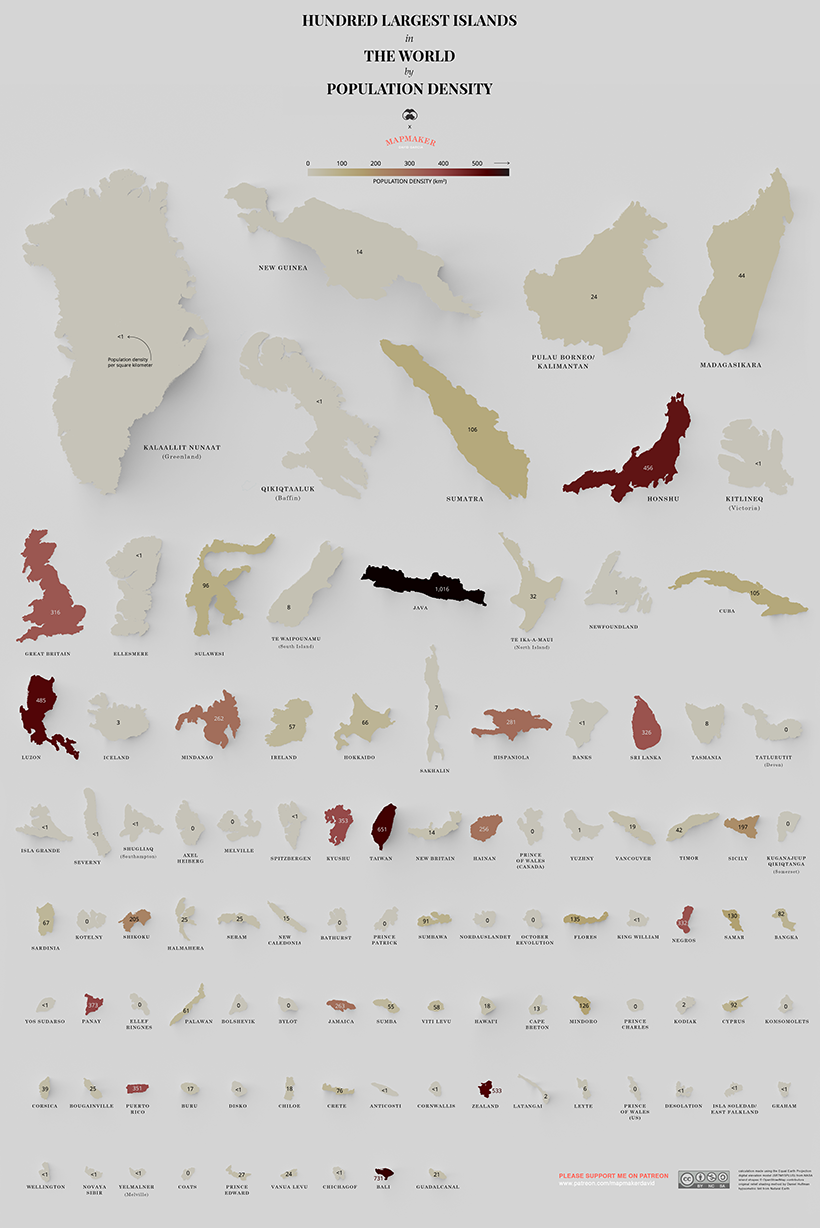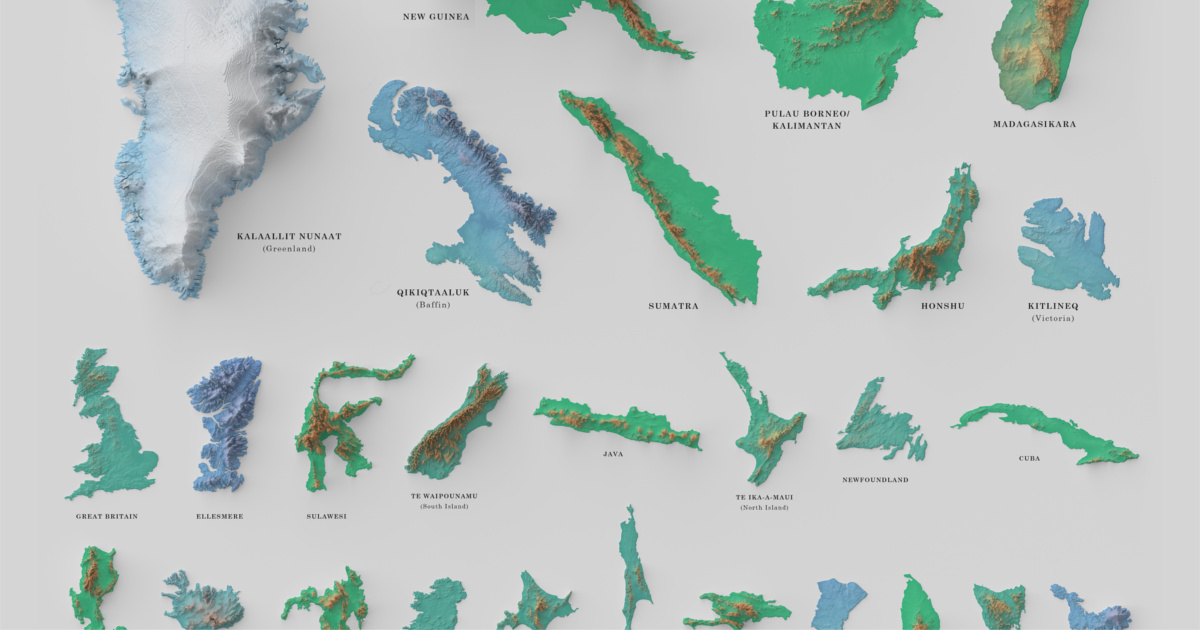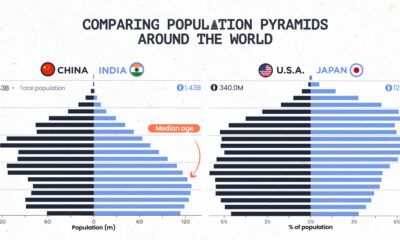Misc
Visualizing the World’s 100 Biggest Islands
View the full-size version of the infographic.
Visualizing 100 of the World’s Biggest Islands
View the full-size version of the infographic by clicking here.
When you think of an island, the first thing that might come to mind is a small, sunny beach surrounded by warm waters. But did you know that 11% of the world’s population actually calls islands their home?
Today’s data visualization is designed by mapmaker David Garcia, and it ranks the 100 largest islands found around the world by size.
Islands in the Stream
The 100 biggest islands range from the likes of expansive Greenland to independent Guadalcanal, the largest of the Solomon Islands. But look a little closer, and you’ll see just how much the top contender outshines the rest. Greenland is almost three times the size of the second-biggest island of New Guinea, and you could fit over 408 Guadalcanal islands within it.
In the visualization, the islands are also tinted, depending on the climate they come from. Blue islands are from the polar regions, turquoise islands lie in the temperate zones, and green islands represent the lush tropics. Which of these regions hosts the most islands?
| Island | Countries | Region |
|---|---|---|
| Kalaallit Nunaat (Greenland) | Denmark | Europe |
| New Guinea | Papua New Guinea, Indonesia | Oceania |
| Pulau Borneo (Kalimantan) | Indonesia, Malaysia, Brunei | Asia |
| Madagasikara | Madagascar | Africa |
| Qikiqtaaluk (Baffin Island, Nunavut) | Canada | North America |
| Sumatra | Indonesia | Asia |
| Honshu | Japan | Asia |
| Kitlineq (Victoria Island) | Canada | North America |
| Great Britain | United Kingdom | Europe |
| Ellesmere (Nunavut) | Canada | North America |
| Sulawesi | Indonesia | Asia |
| Te Waipounamu (South Island) | New Zealand | Oceania |
| Java | Indonesia | Asia |
| Te Ika-a-maui (North Island) | New Zealand | Oceania |
| Newfoundland | Canada | North America |
| Cuba | Cuba | North America |
| Luzon | Philippines | Asia |
| Iceland | Iceland | Europe |
| Mindanao | Philippines | Asia |
| Ireland | Ireland, United Kingdom | Europe |
| Hokkaido | Japan | Asia |
| Sakhalin | Russia | Eurasia |
| Hispaniola | Dominican Republic, Haiti | North America |
| Banks Island | Canada | North America |
| Sri Lanka | Sri Lanka | Asia |
| Tasmania | Australia | Oceania |
| Tatlurutit (Devon Island, Nunavut) | Canada | North America |
| Isla Grande de Tierra del Fuego | Panama | South America |
| Severny | Russia | Eurasia |
| Shugliaq (Southampton) | Canada | North America |
| Axel Heiberg (Nunavut) | Canada | North America |
| Melville | Canada | North America |
| Spitsbergen (Svalbard) | Norway | Europe |
| Kyushu | Japan | Asia |
| Taiwan | Taiwan | Asia |
| New Britain | Papua New Guinea | Oceania |
| Hainan | China | Asia |
| Prince of Wales (Nunavut) | Canada | North America |
| Yuzhny | Russia | Eurasia |
| Vancouver | Canada | North America |
| Timor | Timor Leste | Asia |
| Sicily | Italy | Europe |
| Kuganajuup Qikiqtanga (Somerset, Nunavut) | Canada | North America |
| Sardinia | Italy | Europe |
| Kotelny | Russia | Eurasia |
| Shikoku | Japan | Asia |
| Halmahera | Indonesia | Asia |
| Seram | Indonesia | Asia |
| New Caledonia | France | Europe |
| Bathurst (Nunavut) | Canada | North America |
| Prince Patrick | Canada | North America |
| Sumbawa | Indonesia | Asia |
| Nordaustlandet | Norway | Europe |
| October Revolution | Russia | Eurasia |
| Flores | Indonesia | Asia |
| King William (Nunavut) | Canada | North America |
| Negros | Philippines | Asia |
| Samar | Philippines | Asia |
| Bangka | Indonesia | Asia |
| Yos Sudarso | Papua New Guinea | Oceania |
| Panay | Philippines | Asia |
| Ellef Ringnes (Nunavut) | Canada | North America |
| Palawan | Philippines | Asia |
| Bolshevik | Russia | Eurasia |
| Bylot (Nunavut) | Canada | North America |
| Jamaica | Caribbean | North America |
| Sumba | Indonesia | Asia |
| Viti Levu | Fiji | Oceania |
| Hawai'I (Big Island) | United States | North America |
| Cape Breton | Canada | North America |
| Mindoro | Philippines | Asia |
| Prince Charles | Canada | North America |
| Kodiak (Alaska) | United States | North America |
| Cyprus | Cyprus, United Kingdom | Europe |
| Komsomolets | Russia | Eurasia |
| Corsica | France | Europe |
| Bougainville | Papua New Guinea | Oceania |
| Puerto Rico | United States | North America |
| Buru | Indonesia | Asia |
| Disko | Greenland | Europe |
| Chiloé | Chile | South America |
| Crete | Greece | Europe |
| Anticosti | Canada | North America |
| Cornwallis (Nunavut) | Canada | North America |
| Zealand | Denmark | Europe |
| Latangai (New Ireland) | Papua New Guinea | Oceania |
| Leyte | Philippines | Asia |
| Prince of Wales (Alaska) | United States | North America |
| Desolation (Kerguelen) | Antarctic Lands, France | Antarctic |
| Isla Soledad/ East Falkland | Argentina | South America |
| Graham | Canada | North America |
| Wellington | Chile | South America |
| Novaya Sibir (New Siberian) | Russia | Eurasia |
| Yelmalner/ Melville | Australia | Oceania |
| Coats (Nunavut) | Canada | North America |
| Prince Edward | Canada | North America |
| Vanua Levu | Fiji | Oceania |
| Chichagof (Alaska) | United States | North America |
| Bali | Indonesia | Asia |
| Guadalcanal | Solomon Islands | Oceania |
It’s the Island Life for Many
North America dominates with 32 islands out of the top 100, but there’s a catch — twelve of them are uninhabitable, thanks to the frigid Arctic temperatures.
Throw the number of people into the mix and the regional overview gets even more interesting. Compared to the rest of the world, Asian islands are teeming with life.
- 28 Asian islands
Total population: 510.4 million - 14 European islands
Total population: 83.8 million - 32 North American islands
Total population: 40.7 million - 12 Oceania islands
Total population: 18.3 million
Taking things a step further, we’ve remixed the visualization based on population density.
Click below to view the full-size version.
The most populated island in the world, Java is filled to the brim with 141 million people — that’s over a thousand people per square kilometer. This is in part thanks to the capital city Jakarta being located on the island, but experts warn those days may be short-lived. By 2050, scientific models predict that 95% of the city may be underwater, and that Indonesia must scramble to find a new capital.
To finish, here is the 20 most dense islands on the list, in terms of population density.
| Rank by Density | Island | Countries | Population | Area (km²) | People per km² |
|---|---|---|---|---|---|
| #1 | Java | Indonesia | 141,000,000 | 138,793 | 1,015.9 |
| #2 | Bali | Indonesia | 4,225,000 | 5,780 | 731.0 |
| #3 | Taiwan | Taiwan | 23,571,000 | 36,193 | 651.3 |
| #4 | Zealand | Denmark | 3,749,200 | 7,031 | 533.2 |
| #5 | Luzon | Philippines | 53,336,134 | 109,965 | 485.0 |
| #6 | Honshu | Japan | 104,000,000 | 227,960 | 456.2 |
| #7 | Panay | Philippines | 4,477,247 | 12,011 | 372.8 |
| #8 | Kyushu | Japan | 12,970,479 | 36,753 | 352.9 |
| #9 | Puerto Rico | United States | 3,195,000 | 9,104 | 350.9 |
| #10 | Negros | Philippines | 4,414,131 | 13,310 | 331.6 |
| #11 | Sri Lanka | Sri Lanka | 21,440,000 | 65,610 | 326.8 |
| #12 | Great Britain | United Kingdom | 66,040,000 | 209,331 | 315.5 |
| #13 | Hispaniola | Dominican Republic, Haiti | 21,396,000 | 76,192 | 280.8 |
| #14 | Jamaica | Caribbean | 2,890,000 | 10,992 | 262.9 |
| #15 | Mindanao | Philippines | 25,537,691 | 97,530 | 261.8 |
| #16 | Hainan | China | 8,670,000 | 33,920 | 255.6 |
| #17 | Shikoku | Japan | 3,845,534 | 18800 | 204.5 |
| #18 | Sicily | Italy | 5,057,000 | 25,711 | 196.7 |
| #19 | Flores | Indonesia | 1,831,000 | 13,540 | 135.2 |
| #20 | Samar | Philippines | 1,751,267 | 13,429 | 130.4 |
The Australia-Island Debate
Upon first publishing this over two years ago, the most common feedback we heard came from our friends Down Under.
In school, many Australians learned that their beloved country was an “island continent”, and naturally felt it should be included on the list of the world’s 100 biggest islands.
As with anything, there are different schools of thought on this. Upon digging deeper, we believed that Encyclopedia Britannica had a explanatory take on the issue:
“Most geographers consider islands and continents to be separate things. An island is a mass of land that is both ‘entirely surrounded by water’ and also ‘smaller than a continent.’ By that definition, Australia can’t be an island because it’s already a continent.”
–Encyclopedia Britannica
There are, of course, opposing arguments that could be had—but at least this gives some perspective on why Australia was likely excluded from this particular list.
This post was first published in 2019. We have since updated it, adding in new content for 2021.
Misc
How Do Chinese Citizens Feel About Other Countries?
What is the Chinese public’s view of world powers? This visual breaks down Chinese sentiment towards other countries.
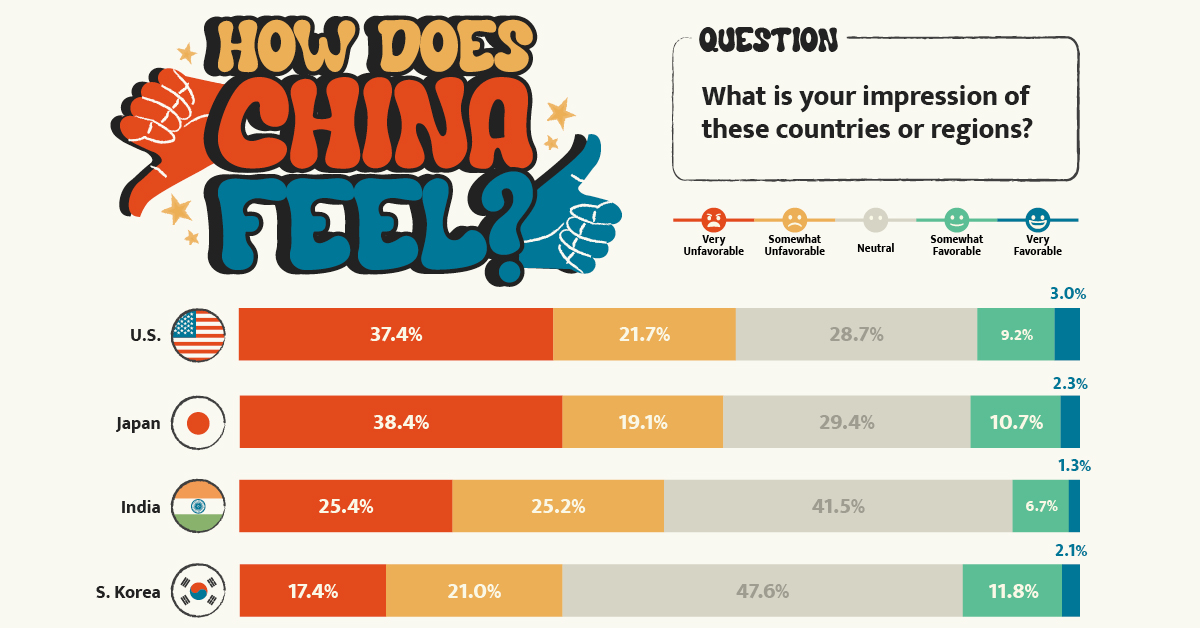
Public Opinion: How Chinese Citizens Feel About Other Countries
Tensions over Taiwan, the COVID-19 pandemic, trade, and the war in Ukraine have impacted Chinese sentiment towards other countries.
This visualization uses data from the Center for International Security and Strategy (CISS) at Tsinghua University to rank survey responses from the Chinese public on their attitudes towards countries and regions around the world.
Chinese Sentiment Towards Other Countries in 2023
In the Center’s opinion polls, which surveyed a random sample of more than 2,500 Chinese mainland adults in November 2022, Russia came out significantly ahead.
Just under 60% of respondents held Russia in a favorable view, with 19% seeing the country as “very favorable.” Contrast that to the mere 12% that viewed the U.S. in a positive light.
Here’s a closer look at the data. The percentages refer to the share of respondents that voted for said category.
| Country/Region | Very Unfavorable | Somewhat Unfavorable | Neutral | Somewhat Favorable | Very Favorable |
|---|---|---|---|---|---|
| 🇺🇸 United States | 37.4% | 21.7% | 28.7% | 9.2% | 3.0% |
| 🇯🇵 Japan | 38.4% | 19.1% | 29.4% | 10.7% | 2.3% |
| 🇮🇳 India | 25.4% | 25.2% | 41.5% | 6.7% | 1.3% |
| 🇰🇷 South Korea | 17.4% | 21.0% | 47.6% | 11.8% | 2.1% |
| 🇪🇺 European Union | 9.3% | 15.6% | 57.6% | 14.1% | 3.3% |
| Southeast Asia | 7.1% | 13.1% | 59.5% | 16.8% | 3.5% |
| 🇷🇺 Russia | 3.0% | 4.8% | 33.7% | 39.4% | 19.0% |
Japan ranked just below the U.S. in terms of overall unfavorability, though a slightly higher share of respondents saw Japan as “very unfavorable” compared to America. This is likely due to both modern tensions in the East China Sea over mutually claimed islands and historical tensions over the Sino-Japanese Wars.
Chinese sentiment towards India was also unfavorable at just over 50%, though notably the country also received the lowest favorability rating at just 8%.
Additional Survey Findings
The survey also found that 39% of Chinese people get their information on international security from Chinese state-run media (mainly through TV), with an additional 19% getting information from government websites and official social accounts. Conversely, only 1.7% get their news from foreign websites and foreign social media, partially due to the Great Firewall.
When asked about different international security issues, the biggest shares of Chinese citizens ranked the following as their top three:
- Pandemics (12.9%)
- Disputes over territory and territorial waters (12.9%)
- China-U.S. relations (12.0%)
The pandemic’s high score reflects the harsher impact COVID-19 had on China. Chinese borders were shut for years and the public faced intense measures to reduce spread.
In terms of other world events, the majority of Chinese people align with a more “Eastern” viewpoint. For example, in regards to the war in Ukraine, the report found that:
“About 80 percent of the respondents believe the U.S. and Western countries should be held most accountable [for the war], while less than ten percent of the respondents argue that Russia is mainly responsible.”– Center for International Security and Strategy, Tsinghua University
Overall, the views of the Chinese public reflect the opposite of those found in many Western countries. They provide an important insight that it is not just the Chinese government holding particular views about the world, but the Chinese public as well.
-

 Energy3 weeks ago
Energy3 weeks agoHow Big is the Market for Crude Oil?
-

 Crime6 days ago
Crime6 days agoMapped: The Safest Cities in the U.S.
-

 Markets2 weeks ago
Markets2 weeks agoRanked: The Most Profitable U.S. Companies, by Sector
-

 Technology5 days ago
Technology5 days agoHow Long it Took for Popular Apps to Reach 100 Million Users
-

 Markets4 weeks ago
Markets4 weeks agoThe World’s Biggest Mutual Fund and ETF Providers
-

 Brands2 weeks ago
Brands2 weeks agoBrand Reputations: Ranking the Best and Worst in 2023
-

 Environment5 days ago
Environment5 days agoHotter Than Ever: 2023 Sets New Global Temperature Records
-

 Datastream4 weeks ago
Datastream4 weeks agoCan You Calculate Your Daily Carbon Footprint?

